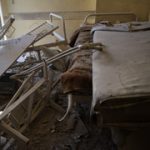Full names have not been used in this post in order to protect individuals’ security.
Dr. H has treated bombing casualties, chemical weapons survivors, and victims with bullet wounds – all standard cases in his field hospital in one of the opposition-controlled areas of Syria. Addressing these kinds of traumas day in and day out would be trying enough for most physicians. But, in addition to handling daily cases like these, Dr. H lives with the anxiety that the field hospital itself will be bombed, or that he will be kidnapped and tortured just for doing his job.
Last week, Physicians for Human Rights (PHR) launched a map that documents the attacks that Dr. H lives in fear of each day.
With gruesome daily reporting of the violence in Syria, from besieged areas filled with starving civilians to deadly chemical weapons attacks, the deliberate targeting of health clinics, hospitals, patients, and medical service providers has received nominal attention. PHR’s recent mapping of confirmed attacks on the country’s health community makes it abundantly clear: the Syrian military has declared war on the medical infrastructure in opposition-controlled areas. These widespread and systematic attacks have both short- and long-term consequences, with particularly harmful effects on civilians. PHR’s map, which contains videos and photographs illustrating attacks on health care in Syria, is a testimony to the courage of citizen journalists who take enormous risks to post information recording the violence. The map plots 150 attacks on 124 separate medical facilities, 90 percent of which were carried out by government forces.
To be clear, clinics, hospitals, ambulances, and medical service providers are protected under the laws of war. Yet, the Syrian government is repeatedly bombing hospitals until they are destroyed. And the attacks are not limited to the health system’s infrastructure. Doctors, nurses, pharmacists, medics, ambulance drivers, and medical students are also under fire. As of April 2014, PHR had confirmed the death of 468 medical service providers, some of whom were killed during attacks on hospitals, clinics, and ambulances, while others were detained and tortured to death in Syrian prisons.
The muted outcry from other governments and the United Nations at these attacks is disturbing. Without strong condemnation and accountability, there is a risk that attacking doctors and clinics will become the new normal in armed conflict. This is not acceptable.
The protective shield of the red crescent and red cross was created to protect civilians and wounded combatants so that they can receive health care in times of war. The Geneva Conventions establish standards to ensure that militaries and armed groups take specific measures to protect civilians from harm. But in Syria’s civil war, civilians are actively being targeted and then denied life-saving medical care.
We need to recover our sense of horror at war. The deliberate targeting of civilians – and those risking their lives to treat the wounded ¬– is unacceptable. In the short term, injured civilians are more likely to die because they cannot access medical treatment. Long term, people suffering from chronic diseases that are largely manageable will suffer and die because routine care is no longer available. Moreover, significant time and resources will be required to rebuild the medical infrastructure in post-conflict Syria, train doctors and nurses to replace those who have been killed or displaced, and address the health consequences of prolonged denial of medical care to the population.
In addition to providing care while under direct attack, doctors in Syria must also protect themselves from detention and torture. Why would Assad, a doctor himself, deliberately target others of the same profession? It’s simple: doctors and other health professionals are commonly the first witnesses to the use of indiscriminate or illegal weapons; they can recognize the signs of torture; they can document evidence of sexual violence; and when they speak out, they provide powerful, compelling testimony.
Detaining, torturing, and killing doctors and other first responders is the government’s way of trying to hide the truth and intimidate those willing to raise their voice. But in today’s digital world, it is impossible to bury the truth for long. The new normal for Dr. H and his colleagues cannot be allowed to stand. We must all speak out on their behalf and demand that medical professionals and facilities be protected and that doctors be allowed to do their work without fearing for their lives.

